As the golden hues of autumn give way to the crisp frost of winter, it’s time for pond enthusiasts to think about winterisation – a crucial process for maintaining a healthy pond ecosystem during the colder months.
Whether you’re a seasoned pond keeper or new to the world of aquatic gardening, this guide will navigate you through the essentials of preparing your pond for winter, ensuring it emerges in spring as vibrant and thriving as ever.
As we approach winter, pond owners must pivot their attention to winterising their ponds. This not only safeguards the aquatic life but also ensures that it will thrive in the seasons to come. So, keep reading as we dive into some important steps for pond winterisation and pond maintenance tips.
1. Assess the Pond’s Condition
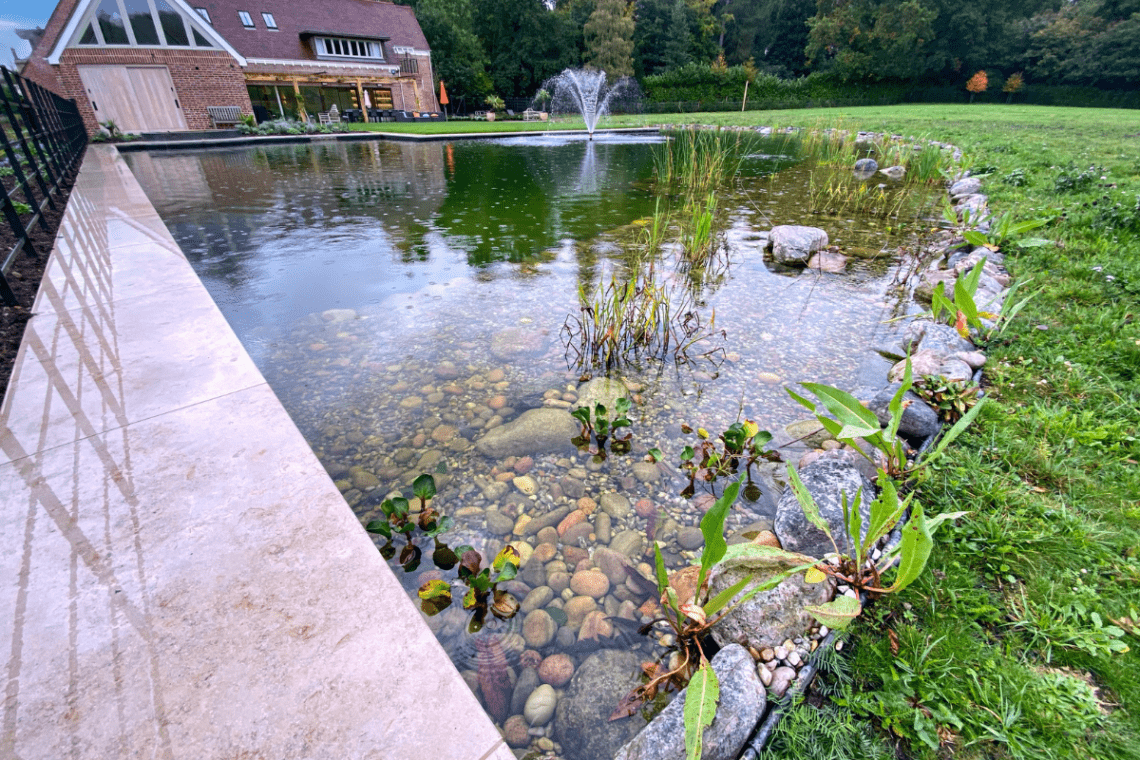
Begin your winter preparation by thoroughly inspecting your pond. This includes checking for any signs of leaks, which could worsen during the colder months.
Examine the liner for any tears or weak spots. It’s also essential to look over the structural integrity of the pond, including the edges and any stonework, to ensure they’re secure and stable.
2. Clean the Pond
Remove all visible debris such as leaves, twigs, and accumulated sludge from the pond’s bottom. These materials, if left unattended, can decompose in the water, leading to a buildup of toxic gases like methane and hydrogen sulphide during the winter, which are detrimental to fish and plant life.
While keeping the pond clean is essential, over-cleaning can be detrimental as it may remove beneficial bacteria and microorganisms that some plants rely on for nutrition during the winter.
3. Trim and Remove Dead Foliage
Trim back and remove any dead or dying foliage from aquatic plants. Decaying plant matter can release harmful nutrients into the pond, encouraging algae growth and reducing water quality. This step is crucial for maintaining a healthy aquatic environment.
Before the first frost, it’s advisable to trim back dead and dying foliage, which helps prevent decay in the pond and maintains a clean environment for the plants.
4. Adjust Fish Feeding
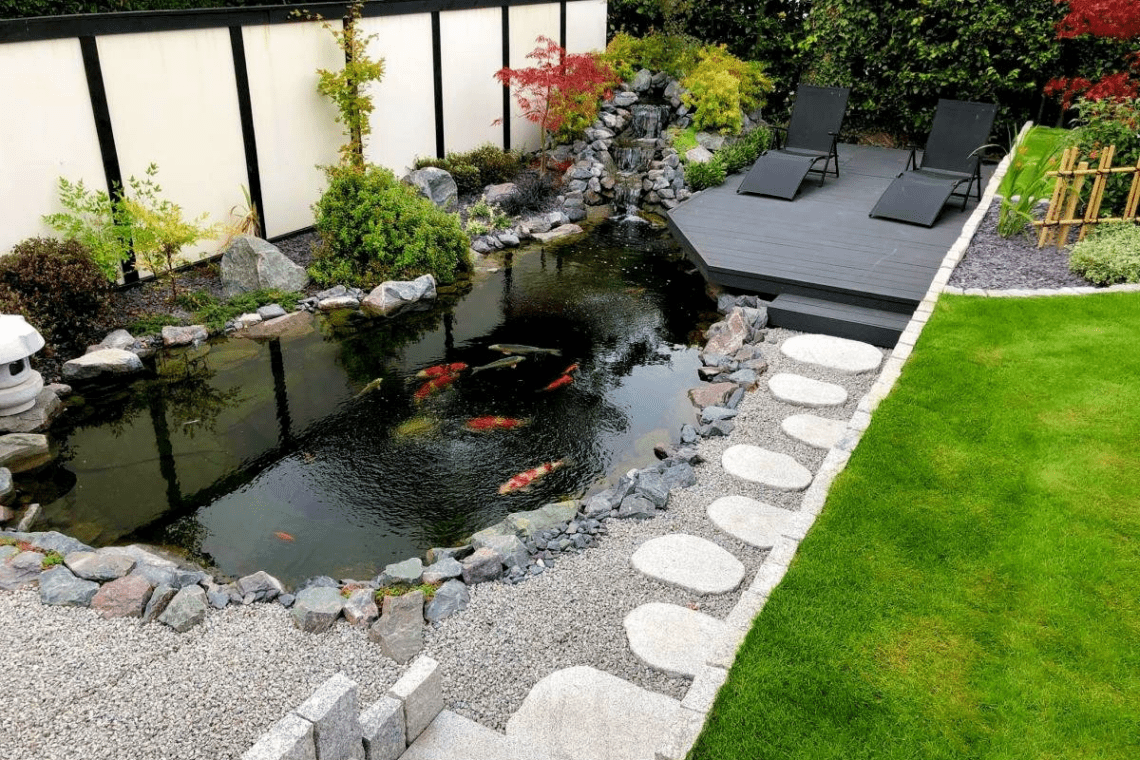
As the temperature drops, the metabolic rate of fish decreases, necessitating a reduction in feeding frequency and quantity. Overfeeding during colder months can lead to uneaten food decomposing in the pond, which can be harmful to the fish. As water temperatures drop, you’ll need to do the following:
- Below 10°C: Switch to wheat germ-based fish food for easier digestion.
- Below 4°C: Stop feeding entirely as fish enter semi-hibernation and can no longer digest food effectively.
5. Install a Pond Heater or De-Icer
Installing a pond heater or de-icer is essential (if your pond has not been built by us) to keep a part of the pond surface from freezing, ensuring adequate gas exchange. This is crucial for the survival of fish and beneficial bacteria, as it allows harmful gases to escape and oxygen to enter the pond water.
If your pond freezes over, it can seriously affect the health of your fish and plants. Backyard ponds installed by us are equipped with a filtration system, which is required to be kept on during winter, circulating warmer water to the surface so it doesn’t fully ice over.
6. Ensure Efficient Aeration
Use an aerator, air pump, or break a hole in the ice to maintain good oxygen levels. This helps in preserving a balanced ecosystem, supporting both fish and plant life. Proper aeration is particularly important in winter when the surface may be partially frozen.
7. Check and Maintain Equipment
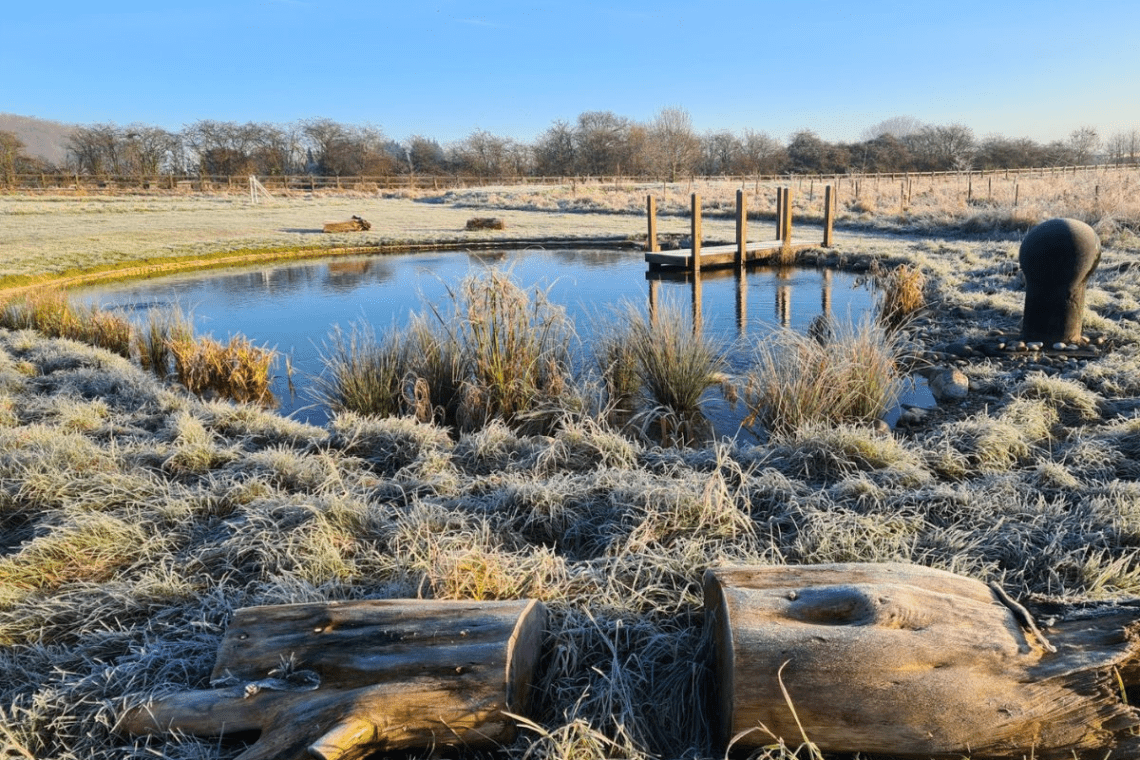
Inspect all mechanical equipment like pumps and filters often. Clean them thoroughly to remove any debris. Store away any equipment that is not necessary during the winter months to prevent damage from freezing temperatures.
8. Balance Water Chemistry
Regularly test the water for pH, ammonia, and nitrate levels. Adjustments might be needed to maintain a balanced water chemistry, which is vital for the health of the pond’s inhabitants. Proper water conditions also reduce the likelihood of disease and algae growth.
9. Cover the Pond
Use full pond netting or a specially designed pond cover to keep out falling leaves and debris. This not only makes spring cleaning easier but also prevents the accumulation of organic matter that can unbalance the pond ecosystem.
10. Running Pond Pumps In Winter Months
A common question for pond owners as winter approaches is whether to keep the pond pump running. Deciding whether to run your pond pump during winter hinges on several factors, including climate, pond size, and the types of plants and fish you have. Understanding the pros and cons is essential for making an informed decision.
Benefits of Running a Pond Pump in Winter
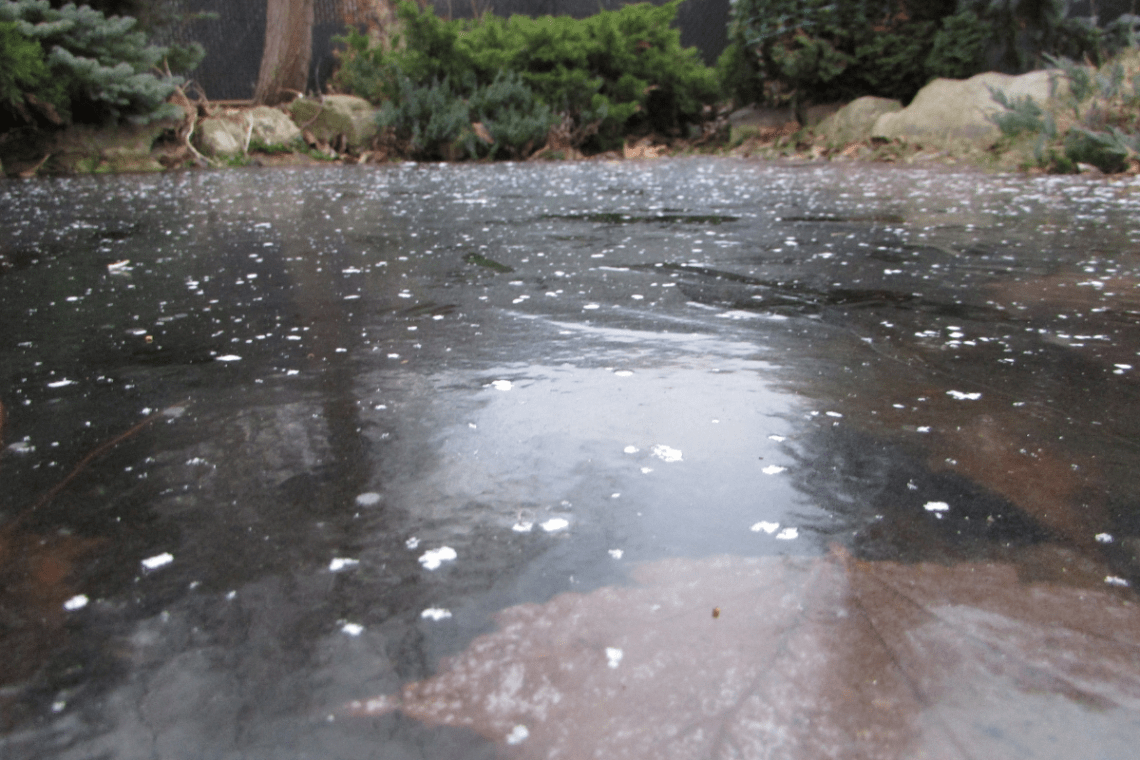
- Prevents Freezing: Keeping the pump running helps to circulate the water, reducing the likelihood of the pond freezing over completely.
- Oxygenation: Continuous water movement aids in oxygenating the pond, crucial for fish and other aquatic life during the cold months.
- Prevents Toxin Build-Up: Water circulation helps to prevent the accumulation of harmful gases by allowing them to escape the water surface.
Considerations for Running a Pond Pump
- Pump Type and Efficiency: Ensure your pump is designed to run efficiently in colder temperatures. Some pumps may not be suitable for winter use and could be damaged by ice formation.
- Water Depth and Ice Formation: In very cold climates, running a pump can lead to ice formation, which might damage the pump or alter the pond’s ecosystem adversely.
- Fish Dormancy: If your pond houses fish that go dormant in winter, they require a still environment. In such cases, running the pump may not be ideal.
- Our Ponds: We recommend keeping your filtration system ON throughout the winter to keep the water circulating.
How to Keep Fish Alive in a Pond Over Winter
Winter presents unique challenges for fish pond owners. Ensuring the survival and health of pond fish during the colder months requires specific care and attention. Focus on the following:
- Regularly check pH, ammonia, and nitrate levels.
- Use a pond aerator or air pump to ensure oxygen levels stay stable.
- Install a pond heater or de-icer to prevent the surface from freezing.
- Insulate the fish pond to keep water temperatures stable.
How to Keep Pond Plants Alive Over Winter
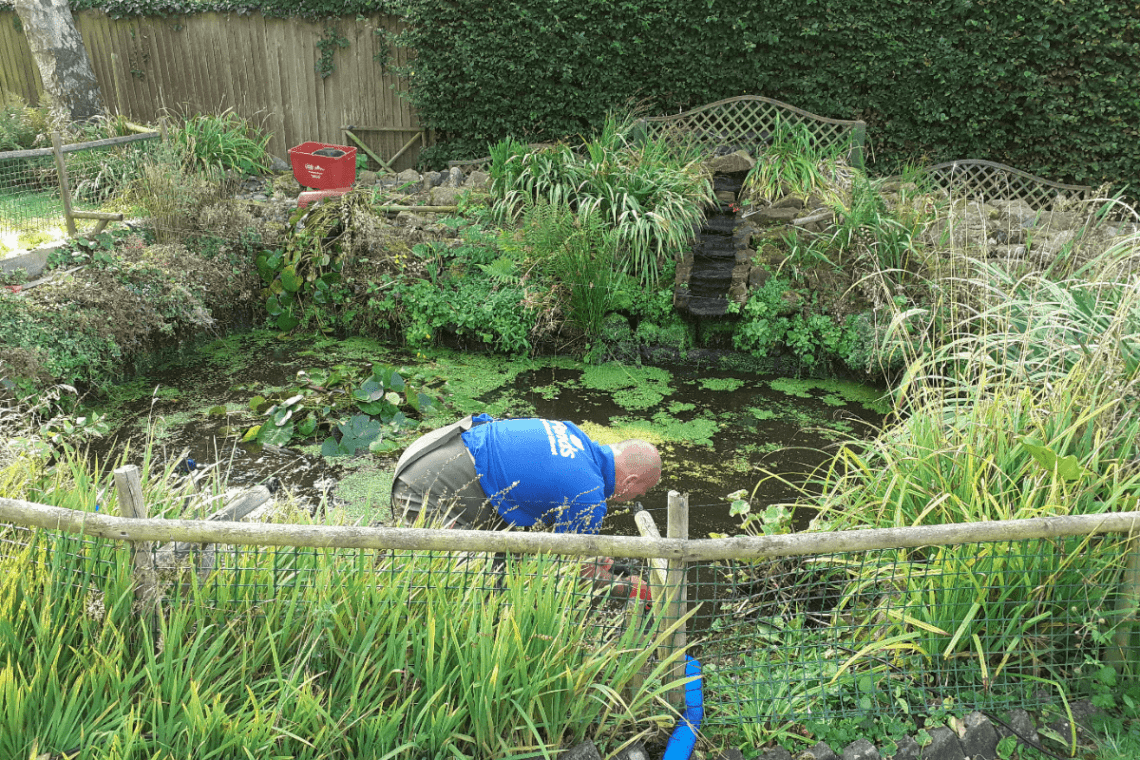
Winter can be a challenging time for pond plants. As water temperatures dip, these aquatic beauties require special care to survive and thrive. Caring for your pond plants during cold winter months is essential to maintaining a healthy and vibrant pond year-round. This ensures that your aquatic garden continues to be a source of joy and beauty.
Protecting Hardy and Sensitive Plants
For hardy aquatic plants, submerging them in the deepest part of the pond is beneficial. This area is less likely to freeze, providing submerged plants a stable environment during winter.
On the other hand, tropical plants and sensitive plants should be moved indoors, kept in containers with adequate water, and placed in a cool, but frost-free area to ensure their survival.
Maintaining the Pond’s Health in Winter
Maintaining water levels in the pond is also important, as water acts as an insulator and helps maintain a more consistent temperature at the bottom of the pond, which is vital for plant roots.
Transitioning Plants for Spring
Finally, when spring arrives, gradually reintroduce plants to the pond environment, considering temperature and light changes to prevent shock. This careful acclimatisation ensures a smooth transition and continued health of your plants.
Wrapping Up Pond Winterisation
As we wrap up our journey through the essentials of pond winterisation, remember that the steps you take now will set the stage for a thriving pond come spring.
From assessing your pond’s condition to ensuring the health of your fish and plants, each action contributes to the overall well-being of your aquatic haven.
If you have any questions about pond cleaning or personalised guidance, feel free to contact us for expert assistance. To ensure your pond receives the best care throughout the year, consider our tailored pond maintenance packages, designed to keep your pond in pristine condition.